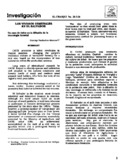| dc.contributor.author | Heckadon M, S. | |
| dc.date.accessioned | 2014-10-18T02:00:57Z | |
| dc.date.available | 2014-10-18T02:00:57Z | |
| dc.date.issued | 1989 | es_ES |
| dc.identifier.uri | https://repositorio.catie.ac.cr/handle/11554/2921 | |
| dc.identifier.uri | http://orton.catie.ac.cr/repdoc/A7081e/A7081e.pdf | |
| dc.identifier.uri | 304098 | es_ES |
| dc.description.abstract | CATIE promotes a silent revolution in Central America: changing the people's traditional culture of "extractive" forestry for a new one, based on the incorporation of tree cultivation within the production systeMON. Long years of silvicultural research by CATIE helped to identify species and techniches well adapted to the natural conditions and forestry needs of small and medium sized peasant land holders, who form the bulk of the region's rural population. But delivering this technology confronted a harsh, reality: forestry projects aimed at the peasantry had failed or achieved limited success. El Salvador is the smallest, most densely inhabited and deforested Country in America. Although it's rural people faced and acute shortage of wood products, it had been reluctant to participate in forestry development projects promoted by the state since the 1950's. Today, however, a growing number of "campesinos" are planting multiple purpose trees on their farMON. A factor behind this change are the "viveros comunales" or communal nurseries, succesfully promoted by the Ministry of Agriculture and CATIE, since 1984. An achievement accomplished in the midt of a civil war, an agrarian reform and a prolongued history of frustrated forestry efforts. The idea of producing trees with "campesinos" so they would them plant them in their farMON rose by trial and error, and chance, in eastern El Salvador. There, extensionists and peasants, devised a simple, but functional organizational method for promoting forestry at the grass roots | es_ES |
| dc.format.mimetype | pdf | |
| dc.language.iso | es | es_ES |
| dc.publisher | CATIE, Turrialba (Costa Rica). Proyecto Cultivo de Arboles de Uso Múltiple | es_ES |
| dc.publisher | CATIE, Turrialba (Costa Rica). Proyecto Cultivo de Arboles de Uso Múltiple | |
| dc.relation.ispartof | Revista Forestal Centroamericana Volumen 2 | |
| dc.rights.uri | https://creativecommons.org/licenses/by-nc-nd/4.0/ | |
| dc.subject | VIVEROS | es_ES |
| dc.subject | BOSQUE COMUNAL | es_ES |
| dc.subject | EXTENSION | es_ES |
| dc.subject | PLANTACION | es_ES |
| dc.subject | PRODUCCION | es_ES |
| dc.title | Los viveros comunales en El Salvador: un caso de éxito en la difusión de la tecnología forestal | es_ES |
| dc.type | Artículo | es_ES |



